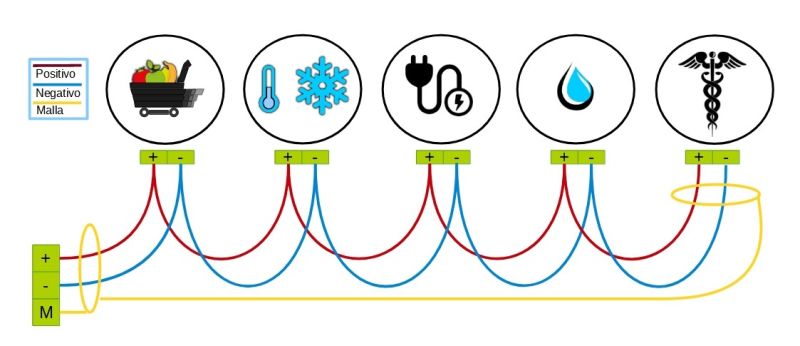CheckWiring/en
Checking the RTU-RS485 modbus wiring
Modbus RTU-RS485 wiring should be checked after start-up of the facility and when starting to visualize communication problems on the platform.
You can consult how to make the Modbus RTU-RS485 Connection by clicking on the {SERVERNAME}}/index.php/Special:MyLanguage/ModbusRTU-RS485 link.
If there are errors, with the help of the graphs, you can have a first visualization of these errors. It is possible that only points are displayed, intermittent cuts, false connections in the control (the control appears as connected even though it is not recording data), intermittent disconnections of the controls on the platform, loss of readings on one bus or several, among others.
Below are some graphs where these intermittent communication failures are identified.



Bus measurement
The points that must be taken into account for the checks are the following:
Polarities
The polarities are those strictly used in the modbus protocol RTU using the Daisy-chain typology described in the wiring requirements.

The polarities must be connected to each other using the terminal block of the kiconex panel or kiBox as the start or end of the line, never connecting to the monitored machines or devices. If the mesh is connected to a machine, the voltage it may have can end up being induced in the communication bus creating electrical noise and conflicts in it, including breaking ports on the kiBox.
Voltage
Voltages in alternating current and direct current must be measured with the help of a multimeter.
The measurements must be made directly on the bus, so the entire bus (positive, negative and mesh) must be DICONNECTED obligatory from the terminal block or from the kiBox if it does not have a panel.
It must be measured between positive-negative, positive-mesh and negative-mesh, both alternating and continuous.
MUST NOT HAVE ANY ALTERNATE VOLTAGE.
In continuous it can possibly have up to 1 Vdc due to the communication flow.
If you have alternating current, you must identify the equipment that is inducing this voltage on the bus and check the wiring to ensure that it is in optimal condition.
The following table may make it easier to collect measurement data:

Continuity
Continuity must be measured between positive-negative, positive-mesh and negative-mesh, this being INEXISTENT.
If there is continuity, the contact that is causing this continuity must be identified and the incident corrected.
To take into account
The communication bus must be away from the power wiring as this can produce noise, the connections within your monitored equipment must also be taken into account.
The bus with NO voltage must be connected to the terminal block of the panel or to the kiBox, this action may lead to failure of the kiBox. If a replacement is made, the buses must be checked before connecting them.
Once the buses have been cleaned and the problematic machines have been isolated, you will have a correct visualization of the readings of the equipment monitored on the platform.
Summary of the previous installation checks.


